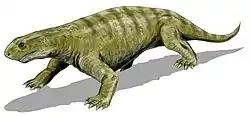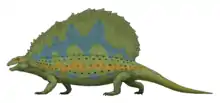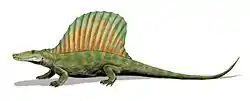Hypselohaptodus
Hypselohaptodus is a genus of sphenacodont synapsid from the Cisuralian of England. It contains a single species, Hypselohaptodus grandis, and is known only from a single specimen, a partial left maxilla, which is hosted at the Warwick County Museum. It was collected at Kenilworth, Warwickshire, England, from the Kenilworth Sandstone Formation (Warwickshire Group), dating to the earliest Asselian stage of the Cisuralian series, about 299 million years ago.[1]
| Hypselohaptodus | |
|---|---|
| Scientific classification | |
| Kingdom: | Animalia |
| Phylum: | Chordata |
| Clade: | Sphenacomorpha |
| Clade: | Sphenacodontia |
| Genus: | †Hypselohaptodus Spindler, 2019 |
| Species: | †H. grandis |
| Binomial name | |
| †Hypselohaptodus grandis (Paton, 1974) | |
H. grandis was originally assigned to Haptodus by Paton in 1974. In 2015 it was determined that H. grandis and Haptodus garnettensis were not congeneric with Haptodus baylei [2] and in 2019 reassigned H. grandis to a new genus, Hypselohaptodus.[3]
References
- R. L. Paton (1974). "Lower Permian Pelycosaurs from the English Midlands". Palaeontology. 17 (3): 541–552.CS1 maint: uses authors parameter (link)
- http://tubaf.qucosa.de/api/qucosa%3A22988/attachment/ATT-0/
- Spindler, Frederik (15 August 2019). "Re-evaluation of an early sphenacodontian synapsid from the Lower Permian of England" (PDF). Earth and Environmental Science Transactions of the Royal Society of Edinburgh: 1–11. doi:10.1017/S175569101900015X. Retrieved 8 October 2019.
This article is issued from Wikipedia. The text is licensed under Creative Commons - Attribution - Sharealike. Additional terms may apply for the media files.




